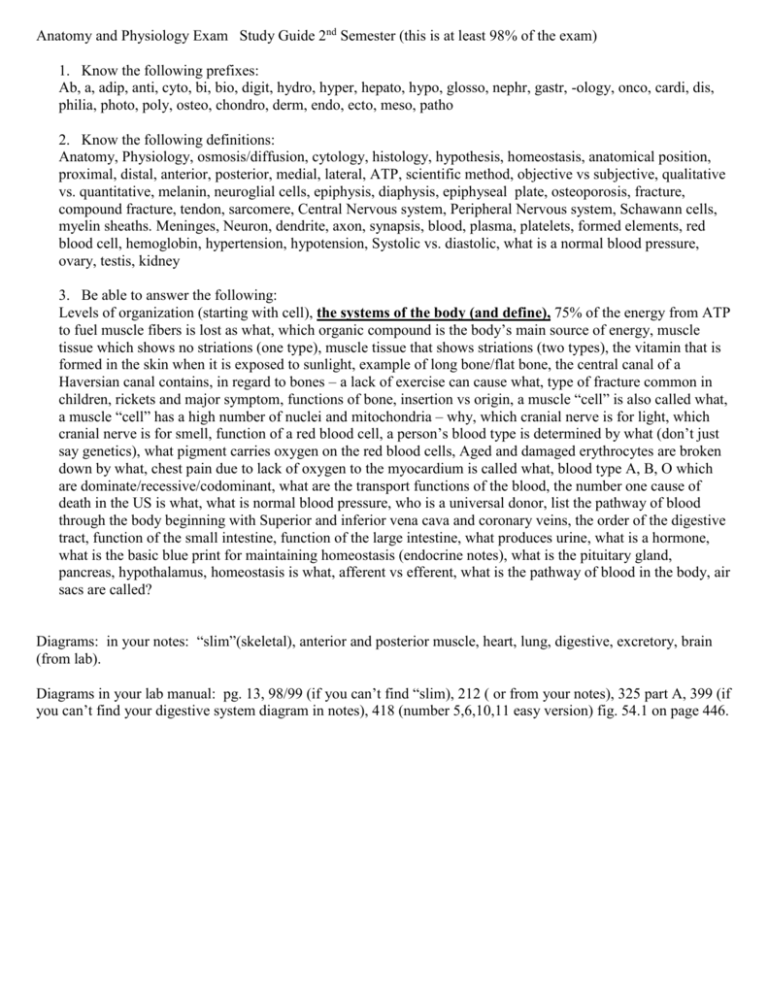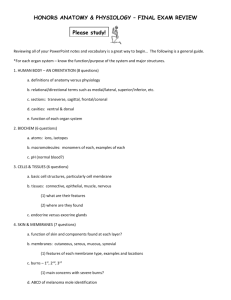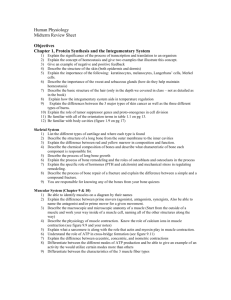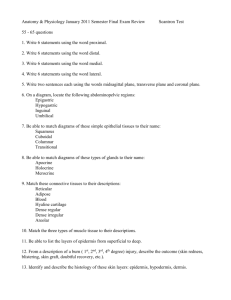1 - Fort Thomas Independent Schools
advertisement

Anatomy and Physiology Exam Study Guide 2nd Semester (this is at least 98% of the exam) 1. Know the following prefixes: Ab, a, adip, anti, cyto, bi, bio, digit, hydro, hyper, hepato, hypo, glosso, nephr, gastr, -ology, onco, cardi, dis, philia, photo, poly, osteo, chondro, derm, endo, ecto, meso, patho 2. Know the following definitions: Anatomy, Physiology, osmosis/diffusion, cytology, histology, hypothesis, homeostasis, anatomical position, proximal, distal, anterior, posterior, medial, lateral, ATP, scientific method, objective vs subjective, qualitative vs. quantitative, melanin, neuroglial cells, epiphysis, diaphysis, epiphyseal plate, osteoporosis, fracture, compound fracture, tendon, sarcomere, Central Nervous system, Peripheral Nervous system, Schawann cells, myelin sheaths. Meninges, Neuron, dendrite, axon, synapsis, blood, plasma, platelets, formed elements, red blood cell, hemoglobin, hypertension, hypotension, Systolic vs. diastolic, what is a normal blood pressure, ovary, testis, kidney 3. Be able to answer the following: Levels of organization (starting with cell), the systems of the body (and define), 75% of the energy from ATP to fuel muscle fibers is lost as what, which organic compound is the body’s main source of energy, muscle tissue which shows no striations (one type), muscle tissue that shows striations (two types), the vitamin that is formed in the skin when it is exposed to sunlight, example of long bone/flat bone, the central canal of a Haversian canal contains, in regard to bones – a lack of exercise can cause what, type of fracture common in children, rickets and major symptom, functions of bone, insertion vs origin, a muscle “cell” is also called what, a muscle “cell” has a high number of nuclei and mitochondria – why, which cranial nerve is for light, which cranial nerve is for smell, function of a red blood cell, a person’s blood type is determined by what (don’t just say genetics), what pigment carries oxygen on the red blood cells, Aged and damaged erythrocytes are broken down by what, chest pain due to lack of oxygen to the myocardium is called what, blood type A, B, O which are dominate/recessive/codominant, what are the transport functions of the blood, the number one cause of death in the US is what, what is normal blood pressure, who is a universal donor, list the pathway of blood through the body beginning with Superior and inferior vena cava and coronary veins, the order of the digestive tract, function of the small intestine, function of the large intestine, what produces urine, what is a hormone, what is the basic blue print for maintaining homeostasis (endocrine notes), what is the pituitary gland, pancreas, hypothalamus, homeostasis is what, afferent vs efferent, what is the pathway of blood in the body, air sacs are called? Diagrams: in your notes: “slim”(skeletal), anterior and posterior muscle, heart, lung, digestive, excretory, brain (from lab). Diagrams in your lab manual: pg. 13, 98/99 (if you can’t find “slim), 212 ( or from your notes), 325 part A, 399 (if you can’t find your digestive system diagram in notes), 418 (number 5,6,10,11 easy version) fig. 54.1 on page 446.











